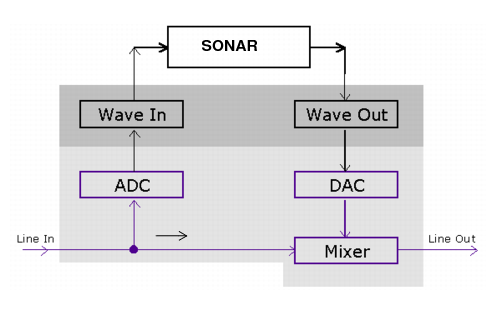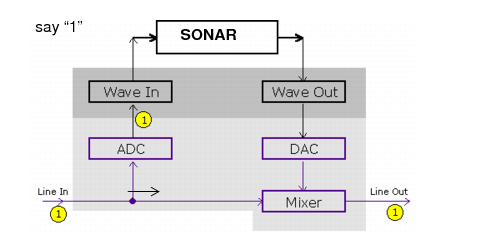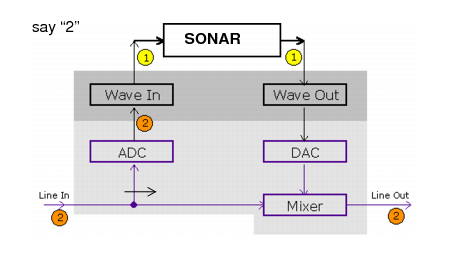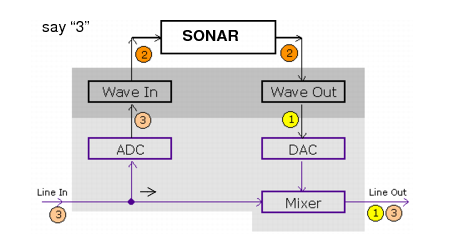Being able to hear plug-in audio effects applied to a live signal is an exciting feature of SONAR. However, there are two issues that users commonly stumble upon when using the
input monitoring feature. The first is that the monitored signal seems to have an echo associated with it. The second is that live input monitoring can lead to nasty feedback problems, particularly if you have an outboard audio mixer, or you record from a different sound card from the one you are playing back with.
SONAR has several buttons to control input monitoring:
To understand the echo and feedback problems, let’s look at how audio signals travel through your sound card, the drivers, and SONAR. The following diagram depicts a simplified version of this signal flow.
The bottom block of the picture represents the sound card. The shaded area above it represents the audio drivers. The unshaded area at the top represents the main environment of the operating system.
As the diagram shows, analog audio flows into the card's line input (on the left), and is immediately split in two. One branch goes up through the analog-to-digital converter (ADC), where the audio is digitized, buffered and fed to the driver (labeled Wave In in the diagram).
The digital audio data buffers are read by SONAR from the Wave In driver, processed, and then sent out to the Wave Out driver. The driver passes the digital audio buffers through a digital-to-analog converter (DAC), where the audio data is converted back to an analog signal.
Suppose you are counting "1, 2, 3" into your sound card very quickly. When you say the first "1," this sound immediately appears in all the places indicated in the illustration above. In other words, the analog audio signal is pure electrical signal traveling at the speed of light, so it is immediately present across all analog audio paths inside the sound card.
Next, you say "2." In the time it takes you do that, the ADC has converted the "1" to digital form and the Wave In driver has fed it to SONAR for processing. SONAR processes the buffer right away and passes the processed data right back to the Wave Out driver.
Finally, you say "3." By this time the original "1" has been converted back to analog audio by the DAC, and that analog signal is mixed in with the "3" you have just said. The ultimate result is that you hear a "1" and "3" mixed together at the line output of card—seemingly sounding like an echo, but actually just an artifact of the signal flow through the system.
You can eliminate the echo by muting the line-in from playing back (see To eliminate the echo from input monitoring); you’ll send only the processed signal to the sound card outputs. This technique introduces a little extra latency to what you hear coming out of your sound card, but if you use WDM or ASIO drivers with your sound cards, the latency is negligible.
The feedback problem results whenever you have a loop in your mixer path: the output of your mixer is patched into the input of your sound card. Feedback can happen with or without input monitoring, but since input monitoring can add several levels of gain to the signal flow, it’s of greater concern when you have input monitoring enabled. Input monitoring is disabled by default when you install SONAR, and you enable it with the following procedure.
Now you can hear your instrument in real time with any plug-in effects that you want to patch into the current track. You might also hear an echo, because the dry signal is coming out of your sound card slightly ahead of the processed signal. To eliminate the dry signal, see the next procedure.
SONAR makes it possible to automatically enable input monitoring when arming a track for recording. To do so, hold down the SHIFT key while you click on a track’s
Arm button

. Likewise, holding down the SHIFT key while disabling record during playback will disable input monitoring.

that turn’s that track’s input monitoring on or off.

in the Control Bar’s Mix module turns input monitoring on or off on all audio tracks with one click.

in the Control Bar’s Mix module so it dims.

. To disable monitoring for this track, click the button off.

button in the Control Bar’s Mix module. This enables input monitoring on all tracks. To disable monitoring for all tracks, click the button again.
Now you can hear your instrument in real time with any plug-in effects that you want to patch into the current track. You might also hear an echo, because the dry signal is coming out of your sound card slightly ahead of the processed signal. To eliminate the dry signal, see the next procedure.
. Likewise, holding down the SHIFT key while disabling record during playback will disable input monitoring.
Go to Edit > Preferences > Audio - Playback and Recording and clear the Disable Input Monitoring during Playback check box.






